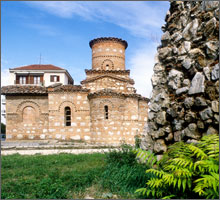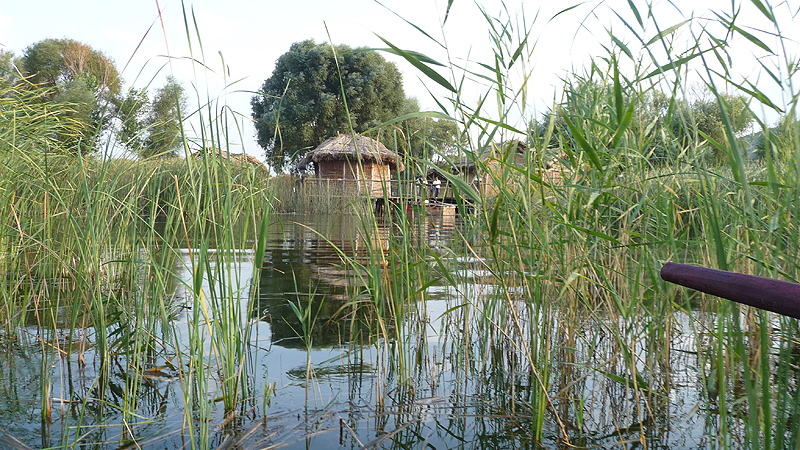Picture: http://www.mpetskas.gr
You will fall in love with the place as soon as you exit the turns among the hills. This city by the lake is different.
This is one of the most beautiful cities of Greece. And this beauty is due to many factors. Firstly, the city of Kastoria is built on the "throat" of a peninsula that reaches Lake Orestiada at an altitude of 620 metres. Other factors include the 74 churches and approximately 140 large houses - all of which are architectural masterpieces dating back to the 17th and 18th century and built of stone and wood. Nature, sights of the area and, of course, the vivid city and its nightlife add to all this.
According to mythology, Kastoria was named after Zeus’s son - Kastoras. It is also possible that the name came from the Bulgarian word “Kostour”, meaning fortress. The history of the city is rich. According to Roman historian Livy, in the 5th century BC there was a town called Keletron at the place where the city lies today, and in the 6th century AD Procopius mentioned the name of Kastoria for the first time as a lake’s name.
During the Byzantine period, the natural beauty of the place attracted the interest of emperors. Originally, the town was fortified by Diocletian who built a new city - Diocletianopolis. In 550, Justinian turned the city into the strongest fortress with reinforced walls in order to withstand Slavic invasions and renamed it to Justinianopolis. After the fall of the Byzantine Empire, the town was conquered by the Turks and was liberated in 1912.
Today it is a modern city with 20,000 inhabitants and numerous inscriptions in Cyrillic. Here, Russians are the best customers of local furriers.
A few years ago, Kastoria was a very wealthy city and its residents had the highest income per capita in the world. Wealth came from furs and artisans known since Byzantine times. Here, 30% of world production is produced, which is sent to international markets and nearly all inhabitants were engaged in fur. Today, fur trade is going through a crisis and townspeople are engaged in tourism.

The first apartment block was built in 1972. Despite all the wealth, people obvious like living in a box. At least the blocks are tiled and somehow save the situation with regard to aesthetics. The locals are very hospitable to visitors, while, at the same time, they are strong competitors among themselves.
What to see...

The Monastery of Panagia Mavriotissa – at the end of the peninsula, built in the era of Alexios I Komnenos (1081 to 1118). The special location of the town endows it with two coasts – a northern and a southern coast. A coastal road covered with sycamore trees starts from the south beach and goes round the entire peninsula. Every visitor must take this trip by car. You will also find the monastery there. Be sure to see the wall-paintings and light a candle. This trip will take you to a lake full of fish and you will see dozens of fishermen with their rods. You can try various types of fish.
Doltso - in the middle of the south coast, there is a square covered with stones - Doltso Square, where the centre of the city's famous Carnival is located - Ragoutsariya. This is a three-day carnival, which begins on Epiphany; its peak is on 7 January and the carnival ends on 8 January. Its name and its origins lie in Roman times. Near the square you will see a lot of old houses and two of them – Nadzi’s and Emmanuel’s - can be visited if they are open.
The acropolis of the Byzantine fortress of Kastoria - very close to the walls and the two towers, you can find one of the most important Byzantine monuments in Macedonia - Panagia Koubelidiki, as known today. The name “koubelidiki” was attributed during the years of the Turkish occupation. “Koubes” in Turkish means “dome”. This is the only domed church in Kastoria. Its Byzantine name was probably Panagia Skoutariotisa and Akatamahitos (unbeatable) - in honour of the Virgin Mary as the protector of the walls.
The Byzantine and the Ethnographic museums - they are particularly rich.
Trips outside the city

Some 7 kilometres away from Kastoria, on the road to Kozani, you will find the lake settlement of Dispilio. It is located on the southern shore of the lake and was accidentally discovered in 1932. This is the first lake settlement excavated in Greece. Since 1992, excavations have revealed important findings that show that, 7,000 years ago, prehistoric people living in the area knew how to fish, hunt and work the land with advanced tools for the era. Also, they wrote signs on wood in order to communicate. While this writing is still unreadable, its age (dating back to 5,300 BCE) shows that it preceded Linear A. There is an exact reconstruction of the lake settlement on the bank of the lake with huts that have been built on pile platforms.